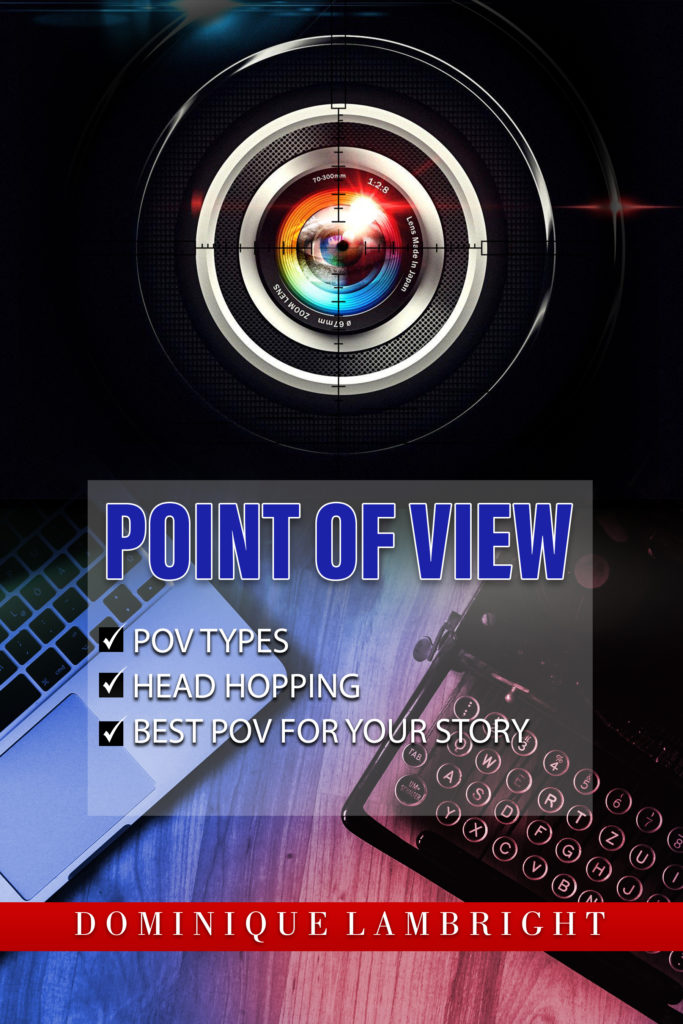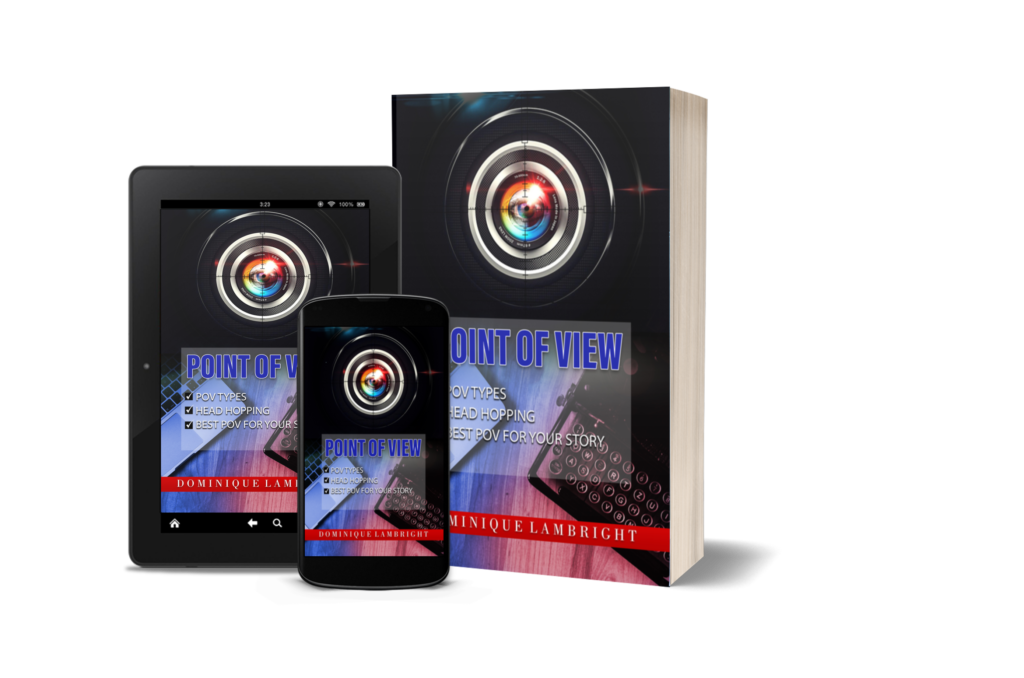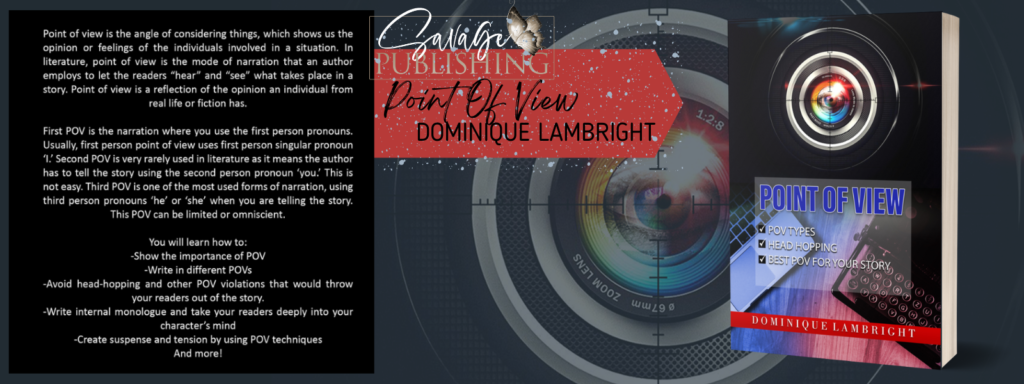Books, Characters, Sneak Peeks
Point Of View Sneak Peek
Synopsis:
Point of view is the angle of considering things, which shows us the opinion or feelings of the individuals involved in a situation. In literature, point of view is the mode of narration that an author employs to let the readers “hear” and “see” what takes place in a story. Point of view is a reflection of the opinion an individual from real life or fiction has.
First POV is the narration where you use the first person pronouns. Usually, first person point of view uses first person singular pronoun I.’ Second POV is very rarely used in literature as it means the author has to tell the story using the second person pronoun ‘you. This is not easy. Third POV is one of the most used forms of narration, using third person pronouns ‘he’ or ‘she’ when you are telling the story. This POV can be limited or omniscient.
You will learn how to:
-Show the importance of POV
-Write in different POVS
-Avoid head-hopping and other POV violations that would throw
your readers out of the story.
-Write internal monologue and take your readers deeply into your
character’s mind
-Create suspense and tension by using POV techniques
And more!

Excerpt:
First-person point of view
Definition
One popular point of view is first person. It is often used in young adult novels to foster reader-protagonist bonding. Aside from being simple to use and compose, the primary character narrator should and always will be prejudiced due to its restricted perception skills. Unless there is contact, this point of view does not fully comprehend the events and other characters.
Books Written in 1st POV
- An Autobiography: The Story of My Experiments with Truth by Mahatma Gandhi
- Jane Eyre by Charlotte Bronte
- The Curious Incident of the Dog in the Night-Time by Mark Haddon
- The Great Gatsby by F. Scott Fitzgerald
- The Hunger Games by Suzanne Collins
- by Harper Lee
Example of 1st POV
Jane Eyre by Charlotte Bronte:
Bessie answered not; but ere long, addressing me, she said—” You ought to be aware, Miss, that you are under obligations to Mrs. Reed: she keeps you: if she were to turn you off, you would have to go to the poorhouse.”
I had nothing to say to these words: they were not new to me: my very first recollections of existence included hints of the same kind. This reproach of my dependence had become a vague sing-song in my ear: very painful and crushing, but only half intelligible.
Voice
The defining feature of a first-person voice is its subjectivity. In a first-person point of view, the story is told from the perspective of a specific character within it. In this respect, the reader is transported directly into the mind and subjective experience of that character, seeing events from their perspective.
Factors That Influence Narrative Speech Pattern
Here is a list of influences for narrative voice:
- Personality
- Age
- Gender
- Religion
- Geographic & Cultural Background
- Education
- Profession
- Current Emotional State
Personality
Your narrator’s personality traits will influence the way he or she speaks and tells the story. A confident person will have a lot of declarative statements and demands, while an insecure character will have suggestions, questions, and sentences that trail off. So, consider the personality of your narrator: Is he chatty or more of the silent type? Down-to-earth or prone to exaggerations? Timid or bossy? Does he ramble or get straight to the point?
Example:
I looked around Betty’s sterile apartment. The living room would look better with a splash of color and a few pillows on the couch.
I looked around Betty’s apartment. It seemed a little sterile. Would it look better with a splash of color? Maybe Betty might want to add a few pillows to the couch.
In the first paragraph, the narrator is confident and doesn’t question her or his own opinion. In the second paragraph, the narrator uses qualifiers such as “a little” and “maybe.” Using a verb such as “might” and a question instead of a statement makes him or her seem less secure of his or her opinion.
Age
Generation and age also influence a narrator’s use of language. If you are writing a novel with a teenage main character, make sure your narrator doesn’t sound like an adult.
Example:
I failed to see what was supposedly so great about being fifteen. Perhaps I would understand the allure in a few years.
Being fifteen sucked. Guess I needed a couple more years to get why everyone thought it was so great.
There might be teenagers who talk like the narrator in the first paragraph, though. Remember that age is not the only factor that influences speech patterns.
Gender
Men and women have different speech patterns. Most men are more direct, while women might use more words to express the same thing. Women use personal pronouns such as “I” and “we” more often, as well as adverbs that express degrees, e.g., “really expensive” or “rather shy.” They also use more details for descriptions. Men use more numbers and also more articles such as “a” and “the” but tend to use fewer adjectives. Of course, these are generalizations, but keep gender differences in mind when you’re writing from the point of view of someone of the opposite gender.
Religion
A devout narrator probably won’t use many curse words, and a Muslim might not use “Jesus” or “Christ” as an exclamation.
Geographic & Cultural Background
Where a person grew up also influences the way he or she speaks. For example, most people from California would refer to a soft drink as “soda” while most people from Illinois would say “pop.” By the way, there’s an entire website on the Pop vs. Soda question. If your protagonist is British, he or she will say “jumper” instead of “sweater” and “trainers” instead of “sneakers.” Use enough regional words to remind your readers of the character’s background, but don’t overdo it. You don’t want your character to come across as a stereotype by tacking “mate” onto every sentence, for example. A good way to know when it’s too much is to ask your beta readers.
Education
People with an academic degree often use longer sentences, fancier words, and correct grammar, while uneducated people might use shorter sentences, simpler words, and sometimes incorrect grammar. Don’t overdo it, though; otherwise, you risk portraying your narrator in a stereotypical way.
Example:
My hand hurt bad. I’d probably need stitches.
My hand hurt badly. I would probably require stitches.
Profession
For some characters, professional jargon might slip into their dialogue and narrative, or they might use metaphors from their profession. For example, Hope, one of the main characters in my novel Heart Trouble, is an emergency physician. When she wonders if she’s losing her mind, she uses the expression “one scalpel short of an instrument tray.”
Current Emotional State
Your narrator’s syntax and word choice will also be influenced by what he or she is feeling right now. If the character is afraid or angry, the sentences tend to be shorter and the verbs more forceful. There might even be a few sentence fragments. If the narrator is relaxed, the opposite will happen sentences will become longer and more descriptive.
Example:
Pain pounded through my temples. I fumbled for the pill bottle on my nightstand. Tylenol. Damn. I needed something stronger. Like Percocet—or a bullet to the head.
I leaned back against the blooming cherry tree, the grass tickling my bare toes. The light breeze brought the scent of daffodils and crocus, and the thrilling soprano of birdsong drifted down from the branches above me.
If you choose a narrator that is different from you in terms of class, education level, age, gender, or any of the other factors I pointed out, you might need to do some research to get the voice right. Eavesdrop on people’s conversations wherever you are. Notice the way they talk.
Advantages
First-Person POV Might Feel Natural
Too many new writers since this is how we tell stories about what happens to us in our everyday life.
Most Immediate & Intimate POV
Since readers share the protagonist’s every thought and emotion, they identify closely with him or her. This is the reason many young adult novels are written from a first-person point of view—because it allows for an instant connection with the protagonist. Readers in that age group are looking for that kind of identification, and for older adults reading a YA adult novel, it’s even more important to find some sort of connection to the character, despite the age difference.
Easier To Maintain
POV violations don’t happen as often because there’s only one “I”.
Disadvantages
Narrows The Scope Of Your Story
You are limited to writing about what your POV character knows, sees, hears, smells, and experiences. If your POV character isn’t there to witness a scene, you can’t write about it, so you can’t explore a wide range of subplots.
No Revealing Other Character’s Thoughts & Emotions
You can, of course, have your protagonist guess what they are thinking or feeling.
The Depth Of Engagement Of The POV
The key to first-person POV is a character who is interesting enough to keep the reader’s attention throughout the entire novel. If the character doesn’t have a strong, engaging voice, that’s like forcing your readers to listen to someone who goes on and on for hours in a boring monotone. If your readers don’t like the character’s voice, they’ll dislike the entire book.
Some Readers Hate First-Person POV
No matter how well written it might be. In comparison, I don’t know anyone who refuses to read books in third-person POV. If you don’t want to limit your audience, a third-person limited POV or deep third-person POV might be a safer bet.
Difficulty Creating Suspense
By keeping information from readers. If your POV character knows who the murderer in a mystery is, for example, your readers need to know it too; otherwise, you’re cheating. For a great example of how you can create suspense in a first-person story without cheating your readers, take a look at A Prayer for Owen Meany by John Irving.
Too Much Time In The Character’s Head
Having him or her think instead of act. Passive characters aren’t very likable, and they stop the forward momentum of the story and make the book drag.
Lots of Sentences Starting With “I”
This can become monotonous. You can avoid that problem, though, by having your POV character focus on things, people, and actions outside of herself or himself.
Harder To Write POV If You & Character Are Different
If there are differences in gender, age, or education and the voice doesn’t come naturally to you.
Describing Your POV Character Can Be Difficult
Without a very good reason, only a vain person would think of his or her own looks.
Common Genres
First-person point of view is common in the following genres:
- YA (young adult)
- Literary fiction
- Chick lit and women’s fiction
- Humorous books
- Urban fantasy
- Crime fiction and mysteries, in which readers can discover the clues and solve the crime along with the detective
First-person POV in romance can be a problem because if readers get insight into the emotions and thought processes of one character only, it limits the identification with the other main character.
It might also not work well for epic fantasy or complex science fiction novels.
Coming Soon to the book shop!



